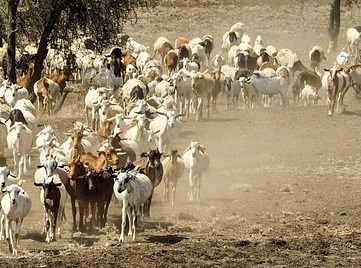Contact
Department of Animal Breeding and Genetics, Department of Animal Breeding and Genetics, Applied Genetics

Indigenous goats make significant contributions to Cameroon's national and local economy, but little effort has been devoted to identifying the populations. Here, we assessed the genetic diversity and demographic dynamics of Cameroon goat populations using mitochondrial DNA (two populations) and autosomal markers (four populations) generated with the Caprine 50K SNP chip.
To infer genetic relationships at continental and global level, genotype data on six goat populations from Ethiopia and one population each from Egypt, Morocco, Iran, and China were included in the analysis.
The mtDNA analysis revealed 83 haplotypes, all belonging to haplogroup A, in Cameroon goats. Four haplotypes were shared between goats found in Cameroon, Mozambique, Namibia, Zimbabwe, Kenya, and Ethiopia.
Analysis of autosomal SNPs in Cameroon goats revealed the lowest HO (0.335±0.13) and HE (0.352±0.15) in the North-west Highland and Central Highland populations, respectively. Overall, the highest HO (0.401±0.12) and HE (0.422±0.12) were found for Barki and Iranian goats, respectively.
Barki goats had the highest average MAF, while Central Highland Cameroon goats had the lowest. Overall, Cameroon goats demonstrated high FIS. AMOVA revealed that 13.29% of the variation was explained by genetic differences between the six population groups. Low average FST (0.01) suggests intermixing among Cameroon goats.
All measures indicated that Cameroon goats are closer to Moroccan goats than to other goat populations. PCA and STRUCTURE analyses poorly differentiated the Cameroon goats, as did genetic distance, Neighbor-Net network, and neighbor-joining tree analyses.
The haplotype analysis of mtDNA showed the initial dispersion of goats to Cameroon and central Africa from north-east Africa following the Nile Delta. Whereas, the approximate Bayesian computation indicated Cameroon goats were separated from Moroccan goats after 506 generations in later times (~1518 YA), as supported by the phylogenetic net-work and admixture outputs. Overall, indigenous goats in Cameroon show weak phylogenetic structure, suggesting either extensive intermixing.
https://doi.org/10.1371/journal.pone.0214843
Tarekegn GM, Wouobeng P, Jaures KS, Mrode R, Edea Z, Liu B, et al. (2019) Genome-wide diversity and demographic dynamics of Cameroon goats and their divergence from east African, north African, and Asian conspecifics. PLoS ONE 14(4): e0214843.